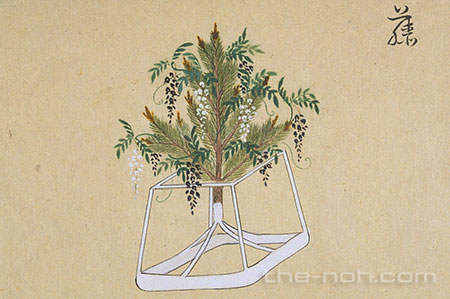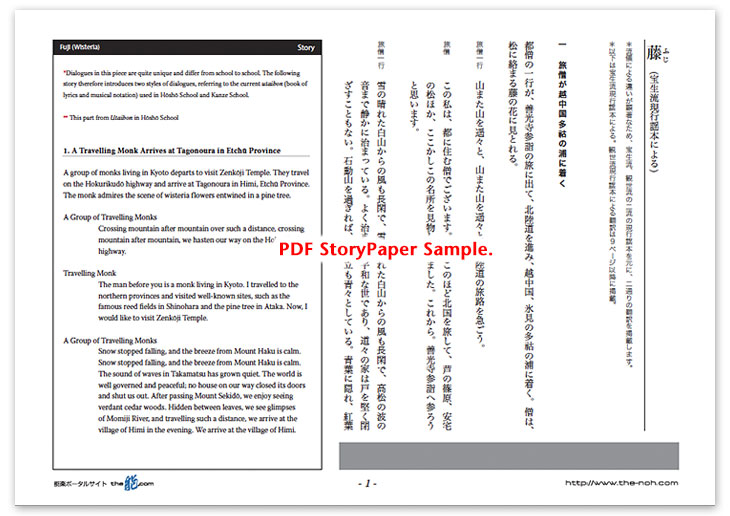
 Fuji (Wisteria)
Fuji (Wisteria)

![]()
A monk living in Kyoto travels on the Hokurikudō highway from the province of Kaga to Zenkōji Temple. When he passes by Tagonoura in Himi, Etchū Province (present-day Himi City in Toyama Prefecture), he notices some beautiful wisteria flowers. When he lays eyes on the flowers, an old poem comes from his lips, but it does not laud the beauty of the wisteria. A woman then appears before the monk. She scolds the monk, saying that since he is in Tagonoura, which achieved fame for its wisteria blossoms, he should have chosen to recite a poem lauding the beauty of wisteria. She insists that he does not understand elegant, refined emotions. The monk asks her identity, since she is familiar with past events. The woman then reveals that she is the spirit of the wisteria and vanishes into thin air.
In the middle of the night, the spirit of the wisteria appears in front of the sleeping monk. She tells him that she has attained enlightenment through the teaching of the Buddha and has become a bodhisattva of the flower. She performs a dance, and eventually daybreak comes. The spirit disappears in the first rays of dawn.
![]()
This drama is in the third group, and its lead character is a female spirit of a flower. The storyline is simple: a traveling monk meets a flower spirit at a well-known place. The story makes use of old poems that describe the ethereal beauty of the wisteria blossoms, and is filled with poetic elegance.
You will enjoy the elegant dance of this third group Noh drama, and the tasteful Noh chants embellished by poetic words. This piece invites you to wander in a dreamy world where you lose your sense of time, far away from reality.
This drama is deeply associated with the locale called Tagonoura. Although the terrain has changed and the size of the lagoon at Tagonoura has decreased dramatically since the time described in this drama, the ancient wisteria tree depicted in “Fuji (Wisteria)” still exists in the local Fujinami Shrine. Visiting the site depicted in the drama is another way of enjoying Noh plays. Please visit the shrine during the season that the wisteria is in bloom.
STORY PAPER : Fuji (Wisteria)
Story Paper presents noh chant stories in modern speech, with story outlines, highlights and more using Adobe PDF format, which can print out and zoom in. Print out the pages and take them with you when you see the actual noh performance.

The copyright of Story Paper is held by the Noh.com. Story Paper is for individual use only. It is prohibited by the copyright law to distribute or publish printed-out Story Paper pages without prior consent. For more information, check the credit and disclaimer pages.



 [Fuji (Wisteria) : Story Paper PDF : 467KB
[Fuji (Wisteria) : Story Paper PDF : 467KB